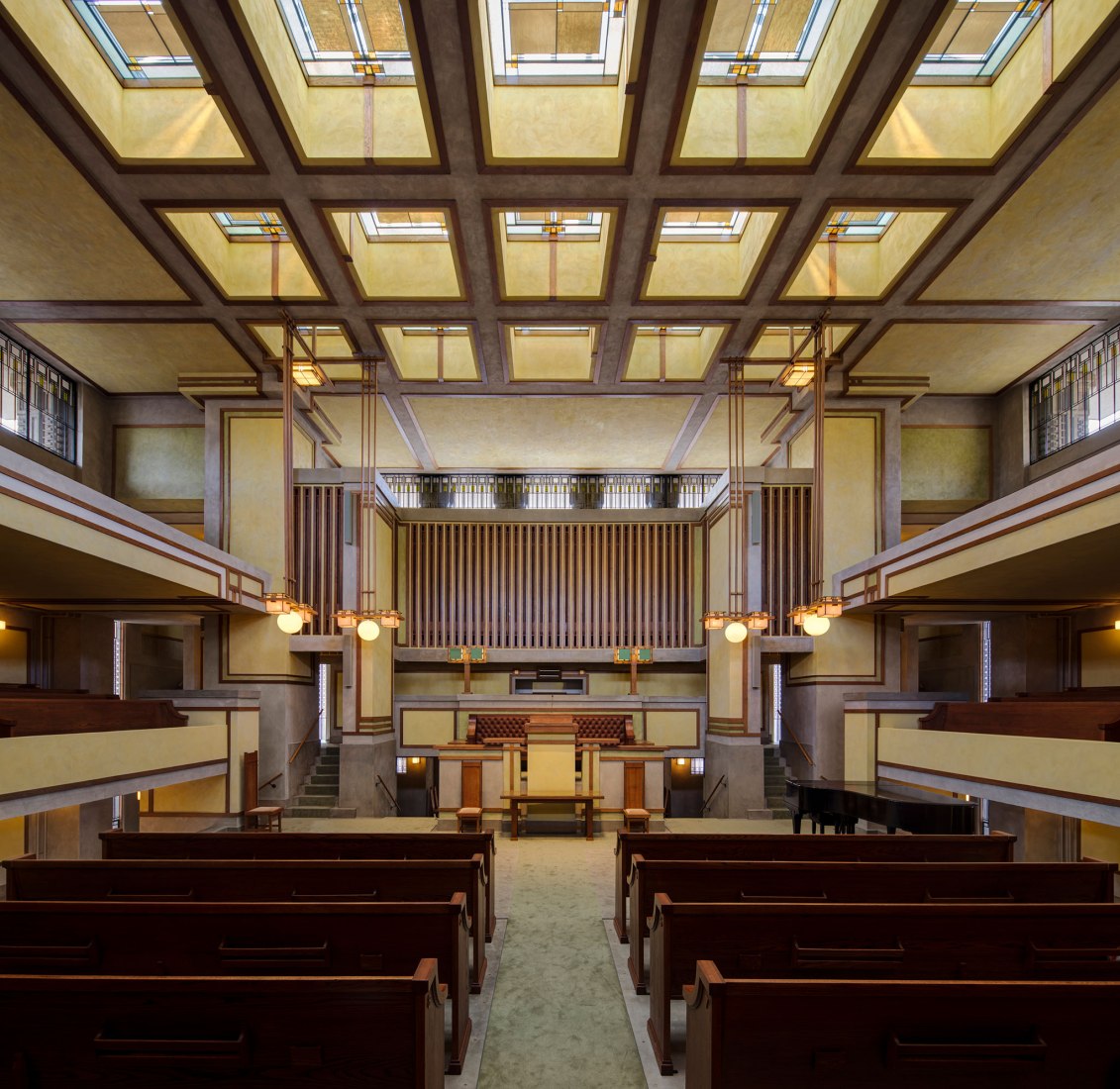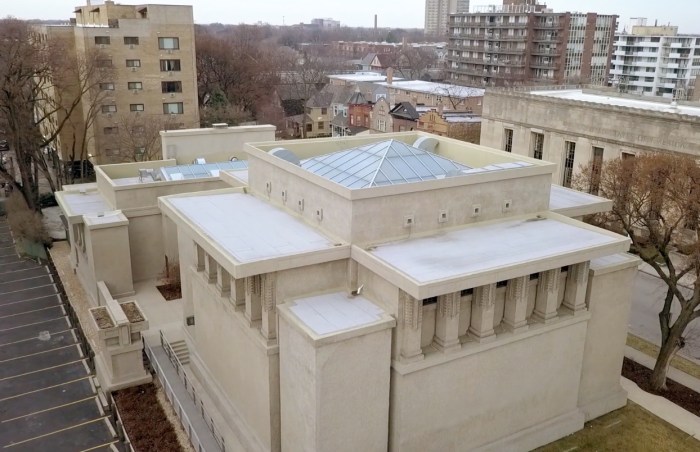Unity Temple by Frank Lloyd Wright: Architectural Highlights sets the stage for this enthralling narrative, offering readers a glimpse into a story that is rich in detail and brimming with originality.
As we delve into the architectural marvel that is Unity Temple, we uncover a world where form and function harmoniously coexist, showcasing Frank Lloyd Wright's pioneering design concepts.
Architectural Style
Unity Temple by Frank Lloyd Wright showcases the Prairie School style of architecture, which is characterized by its horizontal lines, flat or hipped roofs with overhanging eaves, and an integration with the surrounding landscape. This style emphasizes simplicity, craftsmanship, and the use of natural materials.
Key Elements of Unity Temple's Architectural Style
- The use of geometric shapes and forms, such as squares and rectangles, in the design of the building.
- The emphasis on horizontal lines, which create a sense of unity and harmony with the natural environment.
- The incorporation of natural materials like brick, concrete, and wood, reflecting Wright's belief in organic architecture.
- The integration of light and space, with the use of clerestory windows and skylights to bring natural light into the interior.
How Unity Temple Reflects Frank Lloyd Wright's Design Principles
Unity Temple exemplifies Frank Lloyd Wright's design principles, such as his belief in creating buildings that are in harmony with their surroundings and express the spirit of the place. The use of natural materials, the emphasis on horizontal lines, and the integration of light and space all reflect Wright's commitment to organic architecture and his vision of creating a total work of art.
The Prairie School style seen in Unity Temple is a testament to Wright's innovative approach to architecture and his influence on modern design.
Building Materials

Unity Temple, designed by Frank Lloyd Wright, utilized a variety of building materials that were carefully chosen to achieve both aesthetic and functional goals.
The primary building materials used in the construction of Unity Temple include:
Traditional Materials
- Brick: Used for the exterior walls of the building, providing durability and a timeless appearance.
- Concrete: Utilized for the structural elements of the temple, offering strength and stability.
- Wood: Featured prominently in the interior of the building, adding warmth and character to the space.
Modern Materials
- Steel: Incorporated into the design to allow for expansive interior spaces and unique structural features.
- Reinforced Glass: Used in the skylights and windows to bring natural light into the interior, creating a sense of openness.
- Plaster: Applied to the interior walls to achieve a smooth and uniform finish, enhancing the overall design.
The significance of the building materials chosen by Frank Lloyd Wright for Unity Temple lies in their ability to harmonize with the architectural style of the building. By combining traditional materials like brick and wood with modern materials such as steel and reinforced glass, Wright was able to create a space that was both innovative and timeless.
Spatial Design
Unity Temple, designed by Frank Lloyd Wright, showcases a revolutionary approach to spatial design that continues to inspire architects and designers to this day. Wright's innovative layout and organization within Unity Temple not only reflect his signature style but also serve a functional purpose in enhancing the overall experience within the space.
Layout and Organization
The spatial design of Unity Temple is characterized by its open plan layout, featuring interconnected spaces that flow seamlessly into one another. This design choice creates a sense of continuity and unity within the building, allowing for a harmonious experience as visitors move through different areas.
Additionally, the strategic placement of windows and skylights throughout the building ensures ample natural light fills the interior, further enhancing the spatial qualities of Unity Temple.
Functionality Enhancement
Frank Lloyd Wright utilized spatial design in Unity Temple to enhance the functionality of the space. By carefully considering the placement of structural elements, furniture, and circulation paths, Wright was able to optimize the usability of each area within the building.
For example, the elevated pulpit and seating arrangement in the main worship space were strategically positioned to improve sightlines and acoustics, ensuring an immersive and engaging experience for congregants.
Form and Function Relationship
In the spatial design of Unity Temple, Frank Lloyd Wright masterfully integrated form and function to create a cohesive and efficient architectural masterpiece. The unique geometric shapes and spatial volumes within the building not only serve an aesthetic purpose but also contribute to the overall functionality of the space.
Wright's emphasis on the interplay between form and function highlights his commitment to creating spaces that are not only visually striking but also highly practical and purposeful.
Natural Lighting
In the architectural design of Unity Temple, natural lighting plays a crucial role in enhancing the overall ambiance and atmosphere of the space. Frank Lloyd Wright's innovative approach to integrating natural lighting elements into the structure sets this building apart as a masterpiece of modern architecture.
Integration of Natural Lighting
Frank Lloyd Wright strategically incorporated natural lighting elements into Unity Temple to create a sense of unity between the interior and exterior spaces. The use of skylights, clerestory windows, and stained glass windows allows natural light to filter into the building, illuminating the interior with a warm and inviting glow.
The play of light and shadow adds depth and dimension to the architectural details, enhancing the overall aesthetic appeal of the space.
Impact on Ambiance and Atmosphere
- The abundant natural light streaming into Unity Temple creates a serene and tranquil environment, fostering a sense of calm and contemplation among visitors.
- The dynamic interplay of light and shadow throughout the day brings a sense of movement and rhythm to the space, enhancing the spiritual experience for those who gather within its walls.
- The use of natural lighting not only reduces the need for artificial lighting but also creates a connection to the surrounding natural environment, blurring the boundaries between the interior and exterior spaces.
Final Wrap-Up

In conclusion, Unity Temple by Frank Lloyd Wright: Architectural Highlights encapsulates the essence of innovation and timeless beauty, leaving a lasting impression on all who experience its splendor.
FAQ
What architectural style does Unity Temple by Frank Lloyd Wright exhibit?
Unity Temple showcases Wright's Prairie School architectural style, characterized by its horizontal lines, flat roofs, and integration with the surrounding landscape.
What are the primary building materials used in the construction of Unity Temple?
The primary building materials used were reinforced concrete, wood, and art glass, reflecting Wright's emphasis on natural elements and organic architecture.
How did Frank Lloyd Wright utilize spatial design to enhance the functionality of Unity Temple?
Wright's spatial design focused on creating an open and expansive interior that fosters a sense of unity and harmony, while also maximizing natural light and acoustics.
What impact does natural lighting have on the overall ambiance of Unity Temple?
Natural lighting plays a crucial role in shaping the ambiance of Unity Temple, creating a serene and contemplative atmosphere that complements the architectural design.
















